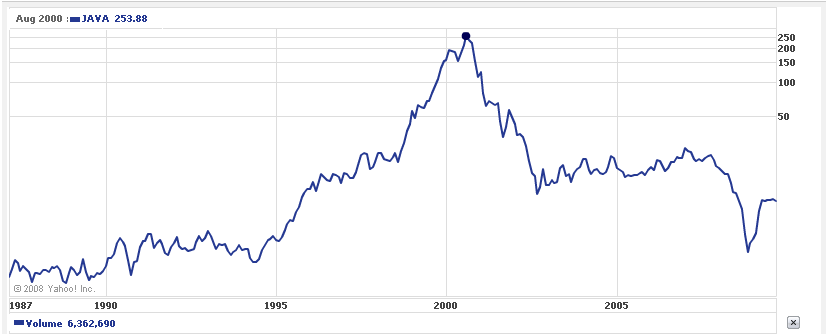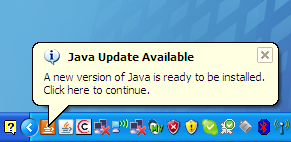Sun Microsystems has always intrigued me. For a number of years, it seemed as if the company could do no wrong. During the early 1990’s, Sun occupied the top position in high performance computer workstations, a category of computing that has since virtually disappeared thanks to advances in PC hardware. Despite desperate attempts to unseat it from its leadership position by worthy competitors like HP, DEC, and IBM, Sun was able to prevail.
If you had purchased Sun stock in May of 1994, you’d have seen it skyrocket to nearly 100 times its value by August of 2000, just 6 years later. Had you kept it at the historical high price of $253/share, you’d have seen your investment lose more than 98% of its value when it came back down to just $3.17 a share by October 2008.

SUNW/JAVA stock price meteoric 100x rise and fall
Sun has always been a leader and innovator. As the workstation market was overtaken by PCs running Windows, Sun became an exceptionally strong competitor in the server market. In 1999, Sun was riding high and looked to be unstoppable. The company was getting lots of positive press about its new language called
Java which sought to be the long awaited ‘write once, run anywhere’ computer language. Presumably, it would be the last computer language that a developer would ever need to learn.
Java had an incredible amount of hype surrounding it. Something that would relegate the Microsoft Windows operating system into a well-deserved irrelevance had finally arrived. No longer would all the popular desktop programs be forced to use Microsoft’s proprietary OS. Instead, applications could be written in Java and run equally well on a Mac, a PC, or any number of Unix-derived operating systems. It was a simple matter of providing a run time environment for each computing platform. That run time environment became known as the Java Virtual Machine (JVM). If you have an orange coffee cup in your systray that always seems to be begging for an update, then that is an indication that you have a Java Virtual Machine on your PC.

The JVM looking for an update
For a while, many websites required the JVM to work properly, but lately I’ve noticed it has become much less necessary. And very few commercial desktop programs require a JVM. Whenever I install a new Windows OS, I can sometimes go for months before realizing I haven’t downloaded Sun’s JVM.
The Java programming language should not to be confused with JavaScript which is a completely different language used primarily in web browsers which was developed independently of the Java programming language. JavaScript was developed by Netscape and was originally called LiveScript. When the folks at Netscape saw the positive response Java was enjoying back in 1996, they made a cross-marketing agreement with Sun to rename LiveScript to JavaScript to tap into Java’s significant cachet. Netscape agreed to promote the Java language in exchange.
Despite all the hopes and dreams of Sun and enthusiastic Java developers, this ‘write once, run anywhere’ promise never achieved its potential. Today it looks even less likely that Java will unseat Windows from its hegemony on the PC. Apple has only recently managed to make some progress on the Windows desktop monopoly by finally breaking through single digit market share of installed base. Apple is now at 10% market share vs. Windows at 88.7% share according to a ComputerWorld report. But when it comes to desktop apps, Apple still relies on Microsoft to deliver the goods in the form of Office applications even for its Mac OS. I guess we’ll see if Google will have better luck than Apple in unseating Microsoft on the desktop with Google’s upcoming desktop OS and cloud computing approach to applications.
After Sun developed Java, it appeared to change directions. Sun seemed to be intoxicated with Java’s assured future success. This infatuation with a language that had failed to achieve its mission in any significant way 12 years after being introduced reached its zenith when Sun changed its stock symbol from SUNW to JAVA in 2007. I think it was Sun’s way of turning its back on its hardware roots in exchange for the promised fortunes of free software. For Sun’s market cap, the downhill slide continued despite the new stock symbol.
I had worked with Sun back in the late 1990’s and found that if you emailed Sun a Microsoft Word document it would be rejected along with a request that you to re-submit it in HTML format. I thought this was rather odd, since Microsoft’s Word was emerging as a defacto standard and surely someone at Sun should have been able to convert it to HTML. But then I found out that Sun employees didn’t have Windows computers and weren’t allowed to buy them. This was around the time that laptops running Windows were becoming indispensable business tools. Sun had acquired an insane hatred for all that emanated from Microsoft to the point where the use of its products was prohibited. In essence, Sun’s management had constructed a reality distortion field for itself and the rest of the company.
Sun acquired StarOffice in 1999. It later offered the software as a free open source “almost-compatible” alternative to Windows Office applications and called it OpenOffice. I’ve used OpenOffice which is the free version of StarOffice, but have found the applications lacking true compatibility. It feels like a product that was built without any apparent business model in mind, unless you consider a quixotic attempt to marginalize your archenemy’s revenue source to be a business model.
Sun had always been vertically integrated, supplying not only its own operating system, but also its own computing hardware all the way down to its Sparc CPU. Sun made some early tentative steps to get its Solaris OS to run on x86 CPUs, but the early efforts never really gained much traction, likely an indication that they were conflicted about making it work. Instead of figuring it out, Sun abandoned those efforts and continued to promote its Sparc architecture, and continues to offer Sparc-based hardware to this day. I believe it was this decision to try to do battle with not just Microsoft, but also with Intel, that furthered Sun’s problems. Sun entered into an alliance with AMD in 2004, but AMD has problems of its own, namely that it has to compete with Intel too. Finally, in 2007, Sun began working with Intel by adopting Xeon CPUs for its high-end servers. But I think it was too late at that point.
In 2004 Sun arrived at a legal settlement with Microsoft, claiming the company was exercising its monopoly position to ruin Java, earning it $1.95 B for its years of legal wrangling. However, I think the damage done to the relationship between the two companies was beyond repair. By the time of the settlement, Sun was hemorrhaging. Giving an ailing company that much cash is like giving it to a crack addict. They’ll only use it to go on a binge and, based on the sort of acquisitions made after that point in time, that’s exactly what happened.
Sun spent $1 billion to acquire MySQL in 2008, an open source database project that was no doubt starting to give Oracle and its competitors cause for concern because it was encroaching on the highly profitable database business. This acquisition did little to boost Sun’s prospects because MySQL really didn’t seem to fit in anywhere at Sun, and it’s hard to imagine there was any potential for revenue since MySQL was already open source and freely downloadable. Only about 1% of MySQL customers were paying for it. That sort of genie cannot be stuffed back in a bottle. To make matters worse, Sun was determined to move it upstream by improving its performance, furthering its threat to database companies who were still charging for their software.
By early 2009, Sun, having lost nearly 98% of its market value and suffering from years of losses or break-even results, was looking to be put out of its misery by being acquired by a rival. IBM appeared to be the front runner but in a surprise bid, Oracle came in and made an offer that Sun accepted instead. The deal is still pending some regulatory approvals.
What Oracle expects to achieve with Sun is anyone’s guess, but I think Oracle made the deal to get its hands on MySQL and to make sure it never becomes a competitive threat to its primary source of revenue. Despite claims to the contrary, Oracle has no need for Sun’s hardware business because it is no longer sufficiently differentiated from the competition. Sun’s software businesses have never made any money when one considers the cost of developing, supporting, and defending them. It’s just mystifying to me what Oracle’s Larry Ellison thinks he’s getting for $7.5 billion. I suppose if the company can be parted out, Ellison will be able to derail further development of MySQL, keep Sun’s $3 billion in cash, and sell off the rest of the company in an effort to recoup the remaining $4.5 billion. Oracle probably won’t risk entering the hardware business and thus alienating key allies like HP, Dell, and IBM when it comes to offering its database server on their hardware. My guess is that once the deal is approved and things quiet down, a fire sale for what’s left of Sun’s assets will ensue.
Sun was a formidable company in its heyday, and I’m sure there are still a lot of smart people there despite Bill Joy’s proclamation to the contrary, now known as Joy’s Law, that ‘most of the smartest people work for someone else’. That statement comes across with such a demoralizing thud that it’s hard to wrap one’s mind around its true meaning. Scott McNealy, Sun’s former President and CEO, known primarily for his sarcastic sound bites about Sun’s competitors and his periodic resurrections, has somehow been silenced. I don’t think he’ll be making a reappearance because Ellison is not the type of person who likes to be upstaged, as can be seen from the YouTube video below where he amuses the audience with his take on Cloud Computing.
Despite the multitudes of really smart people at Sun, its decline, fall, and consumption shows that no amount of technical brilliance can overcome bad decisions on the part of management.




